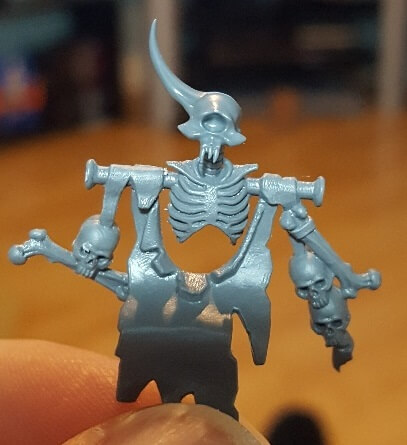I’ve recently been painting a GW Shrine of the Aquila 40K building. Well when I say painting I actually mean airbrushing. I’ve now managed to do a nice mottled blue on the outside of the building and a mottled creamy colour inside. Doing something on this scale really teaches you airbrush control and repeatability, as if two panels look different it will look awful. One thing I have discovered is that light makes a huge difference, so it’s worth having both natural and artificial light available to check. The actual building requires both right and left-handed use of the airbrush and a certain amount of manipulation of the building in order to get into those hard to reach places.
However, onto the actual point of the post… As with many painting projects of this size, there are numerous parts that edge onto each other and as such you cannot afford to have any overspray of one colour onto another. The mottled effect I’ve achieved relies on the black undercoat being used to create darker patches, so any overspray would actually be visible. So the way to ensure that you don’t get any overspray is to mask areas off. This could be an area that you’ve already painted or an unpainted area you wish to keep unpainted. There are a number of different ways of masking off and you will likely find that you will use a mixture of them all in order to achieve the results you want.
Masking Tape. Without a doubt one of the best ways of achieving a crisp edge. You can cut masking tape on a cutting mat to achieve non straight edges, you can actually use a hole punch if you wish to mask off anything round (or the other way round). There are a number of things you need to think about when using masking tape.
- Firstly the choice of masking tape is paramount, it’s no use masking off an area only to find that when you remove the tape, it takes off paint. I would always recommend spending out a bit of cash for Tamiya Low Tack Masking tape. It’s yellow in colour and comes in a number of widths – I’d also suggest you just buy the refils rather than the whole dispenser which is pretty useless in my mind.
- Don’t leave the tape on too long or in a particularly hot or cold environment as it may cause the adhesive to change and pull off paint when you remove it.
- Generally you want to put masking tape on before any other masks. I use a rubber ended sculpting tool to flatten the edge into place – works wonders and means that you don’t push the tape on too firmly and damage the layer underneath. Don’t be afraid to gently remove the tape and reapply if it’s not quite right.
Masking Fluid. This is probably the second most used masking item out there and is basically a rubber based liquid that you ‘paint’ onto the area you wish to mask off. Once dry you can remove it by using an eraser and it should peel off as a film. It takes a little bit of practice to get used to and if you use a brush to apply it, make sure that the brush is well soaped else the fluid will stick to it and mess your brush up. I use a rubber ended sculpting tool to apply it and just rub the excess off with my fingers. I’ve only got a couple of tips really. The first is that you need to test your masking fluid on the colour you are currently using. For example Humbrol Maskol will leave a greasy mark where it was on Space Wolf Grey, where as Windsor & Newton Masking Fluid doesn’t. The second is to experiment with the fluid before you apply it to your actual piece. It’s very easy to put too much on and find it pooling into an edge (a cocktail stick can be used to pull it down).
Plasticard Strip. If I have a gap that isn’t big enough to use either of the above masking methods and is a straight ‘gulley’ then I search my supply of plasticard strip. I’ll trim to size and then use a bit of masking fluid to glue it into place. Simple, but effective. Don’t be tempted to use paper however as as soon as any paint hit’s it, it’ll warp.
A block template. Ok, I’m sure it’s got proper name, but you can hold something in your off hand and use the edge to spray along. I’ll do this with a piece of plastic (actually an old store card) when I’m running along something that doesn’t need as clean an edge as masking tape gives you, such as where a little bit of overspray on the edge doesn’t matter but you don’t want too much. If you’re really skilled it’s possible to hold shaped templates away from a surface and airbrush to achieve a blended shaped edge…
